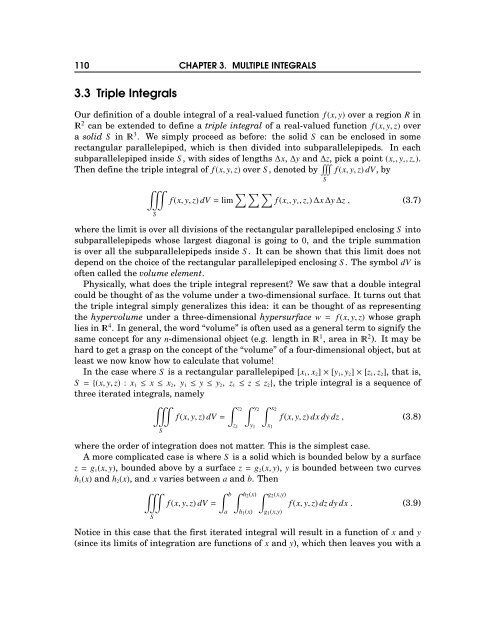Michael Corral: Vector Calculus
Michael Corral: Vector Calculus
Michael Corral: Vector Calculus
You also want an ePaper? Increase the reach of your titles
YUMPU automatically turns print PDFs into web optimized ePapers that Google loves.
110 CHAPTER 3. MULTIPLE INTEGRALS<br />
3.3 Triple Integrals<br />
Our definition of a double integral of a real-valued function f(x,y) over a region R in<br />
2 can be extended to define a triple integral of a real-valued function f(x,y,z) over<br />
a solid S in 3 . We simply proceed as before: the solid S can be enclosed in some<br />
rectangular parallelepiped, which is then divided into subparallelepipeds. In each<br />
subparallelepiped inside S, with sides of lengths∆x,∆y and∆z, pick a point (x ∗ ,y ∗ ,z ∗ ).<br />
Then define the triple integral of f(x,y,z) over S, denoted by f(x,y,z)dV, by<br />
S<br />
<br />
S<br />
∑∑∑<br />
f(x,y,z)dV= lim f(x ∗ ,y ∗ ,z ∗ )∆x∆y∆z, (3.7)<br />
where the limit is over all divisions of the rectangular parallelepiped enclosing S into<br />
subparallelepipeds whose largest diagonal is going to 0, and the triple summation<br />
is over all the subparallelepipeds inside S. It can be shown that this limit does not<br />
depend on the choice of the rectangular parallelepiped enclosing S. The symbol dV is<br />
often called the volume element.<br />
Physically, what does the triple integral represent? We saw that a double integral<br />
could be thought of as the volume under a two-dimensional surface. It turns out that<br />
the triple integral simply generalizes this idea: it can be thought of as representing<br />
the hypervolume under a three-dimensional hypersurface w= f(x,y,z) whose graph<br />
lies in 4 . In general, the word “volume” is often used as a general term to signify the<br />
same concept for any n-dimensional object (e.g. length in 1 , area in 2 ). It may be<br />
hard to get a grasp on the concept of the “volume” of a four-dimensional object, but at<br />
least we now know how to calculate that volume!<br />
In the case where S is a rectangular parallelepiped [x 1 ,x 2 ]×[y 1 ,y 2 ]×[z 1 ,z 2 ], that is,<br />
S ={(x,y,z) : x 1 ≤ x≤ x 2 , y 1 ≤ y≤y 2 , z 1 ≤ z≤z 2 }, the triple integral is a sequence of<br />
three iterated integrals, namely<br />
∫ z2<br />
f(x,y,z)dV= f(x,y,z)dxdydz, (3.8)<br />
x 1<br />
S<br />
z 1<br />
∫ y2<br />
y 1<br />
∫ x2<br />
where the order of integration does not matter. This is the simplest case.<br />
A more complicated case is where S is a solid which is bounded below by a surface<br />
z=g 1 (x,y), bounded above by a surface z=g 2 (x,y), y is bounded between two curves<br />
h 1 (x) and h 2 (x), and x varies between a and b. Then<br />
∫ b ∫ h2 (x) ∫ g2 (x,y)<br />
f(x,y,z)dV= f(x,y,z)dzdydx. (3.9)<br />
S<br />
a<br />
h 1 (x)<br />
g 1 (x,y)<br />
Notice in this case that the first iterated integral will result in a function of x and y<br />
(since its limits of integration are functions of x and y), which then leaves you with a








